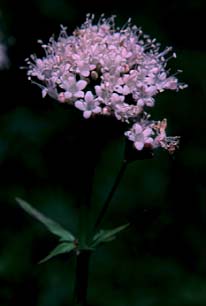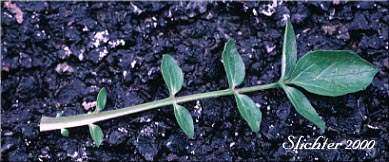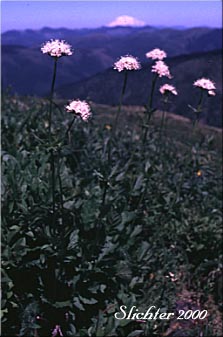 Characteristics:
Characteristics:
Mountain heliotrope is a beautiful wildflower for the moist woodland or meadow garden. It is a fibrous-rooted perennial from a thick, branched rhizome with one or more stems from 30-120 cm tall. The herbage is usually smooth, although occasionally short-hairy. The 2-5 pairs of leaves are mainly found on the stems. The leaves are opposite on the stems, and each is compound pinnate, with 1-4 pairs of lobes below the large terminal leaflet (See photo below.). The petioles are long and thin. The lower leaves are reduced in size, while the upper are much larger. The leaves range from 10-20 cm long. The terminal leaflet is obovate and up to 10 cm long and 7 cm wide. The lower pairs of lobes are often at least 1 cm wide. The leaflet margins are strongly wavy, scalloped, or with large, rounded teeth.
The inflorescence is compact, ranging from 2.5-8 cm wide. The flowers are perfect, with white corollas from 4.5-7 mm long, and the lobes less than half as long as the tube. The stamens are well exserted from the mouth of the corolla.
Mountain heliotrope is palatable to sheep, deer, and elk. The roots are foul smelling and tasting.
Mountain heliotrope is a plant of open to wooded places, especially cool, wet meadows at middle and upper altitudes in the mountains.
Mountain heliotrope may be found from southern Alaska and the southern Yukon south to northern California and east to western Montana and central Idaho. It is evidently not found in the coast range of Oregon nor in the lowlands of the Puget trough and Willamette Valley as it is replaced in those areas by Scouler's heliotrope.
In the Columbia River Gorge, it may be found between the elevations of 3300'-4500' from near Crown Pt. east to near Mt. Defiance.

